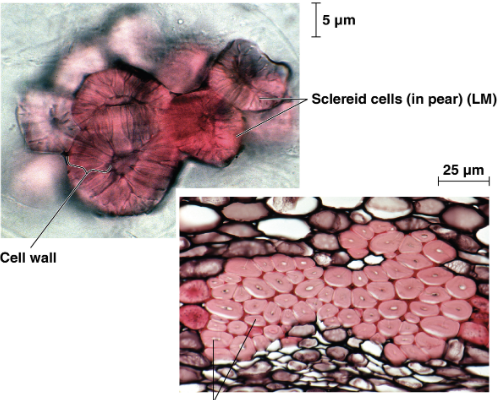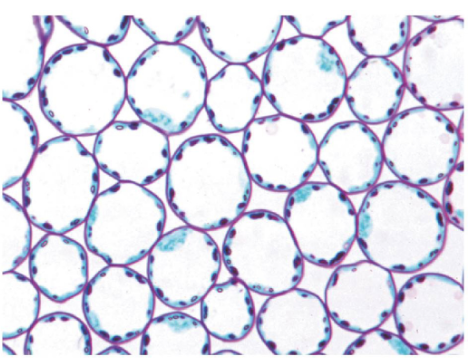Unit III Biology Study Set - Fungal Diversity: Plant Form and Function
1/119
There's no tags or description
Looks like no tags are added yet.
Name | Mastery | Learn | Test | Matching | Spaced |
|---|
No study sessions yet.
120 Terms
Decomposers
Sustaining ones self by secreting hydrolytic enzymes into a given environment, decaying matter, and absorbing the nutrients through networks of filaments
Hyphae
Tiny filaments that absorb decomposed nutrients, and allow cytoplasm to flow through
Chitin
A strong polysaccharide that composes the cell wall - helps aid in absorption and avoids rupturing when in a hypotonic environment
Mycelium
Composed of hyphae that extend up into the fruiting body (fruiting body produces spores)
Coenocytic
Unsegmented hyphae
Septate
Segmented hyphae
Why do Hyphae Lack Well Defined Cells?
Because hyphae need maximum surface area to effectively absorb nutrients
Arbuscules
Structures formed by hyphae that enter into living cells and acquire nutrients
Mycorrhizal Fungi
Fungi that exchange nutrients with the roots of plants, and effectively increase the absorption area of plants (mutualistic relationship)
Asexual Reproduction
Haploid spores produced via mitosis
Fungal Sexual Reproduction
Mating types release pheromones from their mycelia, if a fungi of a different type is nearby, they will grow towards each other and fuse when they meet. Then the haploid nuclei fuse and create a diploid zygote for a short period of time prior to undergoing meiosis and forming haploid spores
Plasmogamy
Fusion of the cytoplasm between two different types of fungi
Heterokaryotic Mycelium
Post plasmogamy when the haploid nuclei from each type of fungi exist in one singular organism
Karyogamy
When the haploid nuclei fuse together and form a diploid zygote
Alteration of Generations
The life cycle of all plants that consist of a gametophyte and a sporophyte stage
Gametophyte
A haploid multicellular organism that produces gametes (the gametes later fuse with each other to form diploid saprophytes)
Sporophyte
A diploid multicellular organism that produce reproductive cells that are capable of developing into additional haploid organisms called spores (these spores continue on and develop into a multicellular gametophyte)
Multicellular Dependent Embryos
During the embryonic development of a sporophyte when it is surrounded, protected and given nutrients by maternal tissue of the gametophyte
Wall Spores
Produced in sporangia - a protein called sporopollenium fills the walls to protect spores from the environment
Spores
Haploid organisms produced in the sporangia of sporophytes
Multicellular Gametangia
Where eggs and sperm are produced as part of the gametophyte stage
Antheridia
Sperm producing gametangia
Archegonia
Female egg producing gametangia
Apical Meristems
A highly mitotic region tip on plants in which they grow from - can develop into a leaf or shoot out a root due to their high stem cell abundance
Cuticle
The waxy outer layer on plants to prevent excessive water loss
Stomata
Opening on photosynthetic organisms that allow for gas exchange - opening and closing regulated by guard cells
Xylem
Transports mainly water and minerals from the root anchoring structures - strengthened by the polymer lignin
Seeds
An embryo packed with nutrients that can be cast away from the parent and survive extended periods of time and germinate (not an apparent feature until angiosperms and gymnosperms develop)
Homosporus
A plant that produces only one type of spore (bisexual gametophyte that will develop into either a male or female gametophyte)
Heterosporus
A plant that can produce multiple kinds of spores (either microsporangium - male gametophyte production or megasporangium - female gametophyte production)
Non-vascular Plant Characteristics
No true roots, seeds, leaves, or vascular tissue
Gametophyte dominant
Thin structures to enable water diffusion
Anchored into the ground via rhizoids (no absorption apparatus)
Flagellated sperm
Phyla Hepatophyta: Liverworts
Nonvascular herbs that use gemma cups to go through asexual reproduction
Gemma Cups
Cups containing small fragments of liverwort tissue that are splashed out by water and grow in surrounding areas into a thallus (thallus: undifferentiated plant body lacking vascular tissue)
Phyla Bryophyta: Mosses
Nonvascular mosses that contain protonemata - branched filaments that are one cell thick that increase allotted surface area for water absorption
Phyla Anthocerophyta: Hornworts
Nonvascular plants recognized by their long and slender sporophyte structure
Moss Foot
Holds sporophyte to the top of the gametophyte
Moss Seta
The stalk that helps raise the sporangia above the gametophytes (and around) for spore dispersal
Capsule
Contains the sporangia
Moss Peristome
Where spores fall out of once wind knocks off the capsule cap and initiates reproduction
Seedless Vascular Plant Characteristics
Contains vascular system with xylem and phloem
Limited lignin production - true leaves and roots are present (megaphylls and microphylls)
No seeds, only spores
Independant gametophyte and sporophyte stages with dominant sporophyte stage
Obtain sporophylls
Sporophylls
Modified leaf that holds sporangia
Phyla Lychophyta: Club Mosses, quillwort, and spike mosses
Vascular (“fake”) mosses with microphyll leaves.
Club mosses are homosporus, while spike mosses and quillworts are heterosporus
Phyla Monilophyta: Ferns, Horsetails, and Whisk Ferns
Nonvascular ferns that are homosprous and have megaphyll leaves.
Seed Composition
endosperm
plant embryo
protective outer coating
Ovule
When fertilized, this develops into a seed
Reduced Gametophyte Stage
All seeded plants have a dominant sporophyte stage that allows for a longer stage of sporangia production
Megasporangium
Diploid structure that gives rise to haploid female gametophytes in which only one of these structures can produce a singular megaspore
Microsporangium
Diploid structure that gives rise to haploid male gametophytes in which each of these structures gives rise to numerous microspores
Ovules
Composed of a megasporangium (2n), megaspore (n), and integument (2n) - once the egg is fertilized by sperm (which is housed in pollen), the development of this structure into a seed begins
Gymnosperm and Angiosperm Integument layers
Gymnosperm: 1
Angiosperm: 2
Pollen Grain
The next developing “destination” of a microspore
Sporopollenin
The composition of the protective layer that encloses the gametophyte
Pollination
The transfer of pollen seeds into the portion of the seed plant containing the ovule (germination occurs if contact with one another is successful and the pollen grain sprouts a pollen tube that extends to reach the ovule - reasoning for why sperm of seeded plants do not need to be motile)
Naked Seed
A term referring to the seed growth of gymnosperms - seeds are not enclosed within an ovary, but rather they develop on leaves or in scales (usually arranged as a cone)
Moniceous vs Dioecious
Male and female pine cones growing on a singular tree vs each cone being found on entirely different trees
Phylum Ginkophyta
Only one species of gymnosperms that retain flagellated sperm and are dioecious
Phylum Cycadophyta
Mostly tropical gymnosperms containing large cones, flagellated sperm, and over 350 species
Phylum Gnetophyta
Desert/tropical gymnosperms that obtain the largest leaves of all time
Phylum Coniferophyta
Most diverse group of gymnosperms with around 600 species - mostly evergreens like pines, firs, junipers, and woody cones
Angiosperm Characteristics
Most dominant terrestrial plant, seeds are contained within fruits that develop into reproductive structures called flowers, sporophyte dominant, and are composed of only one singular phylum: anthophyta
Flower
Specialized reproductive structures that help transfer pollen by attracting pollinators
Sepal
Modified leaf that encloses the flower before it blooms
Petal
Modified, brightly colored leaf that attracts pollinators
Stamen
The microsprorphylls composed of the anther and filament where microspores are produced and develop into pollen grains (filament is simply a stalk, while the anther is where pollen is produced)
Carpels
The container that encloses the seed - megasporophylls composed of the stigma, style, and ovary where megaspores are produced and develop into female gametophytes (the stigma receives pollen, the style connects the stigma to the ovary, and the ovary contains ovules)
Fruits after Fertilization
Following fertilization, the ovary wall begins to thicken and the ovules develop into seeds while the ovary develops into the fruit containing the seeds - maturation into a fruit
Micropyle
The opening in the integument of an ovule that allows a pollen tube to enter
Double Fertilization
Two sperm travel down the pollen tube, one fertilizes the egg cell and forms a diploid zygote, while the other fuses with two nuclei to form a triploid endosperm (protective coating)
Cotyledons
1 or 2 young leaves that develop within the embryo sporophyte
Monocots
Plant embryos containing a singular cotyledon and parallel vein systems
Eudicots
Plant embryos containing two cotyledons and web like vein systems
Fibrous Roots
Roots made up of many branched lateral roots that increase surface area (found in grasses and monocots)
Tap Root
Characterized by one main root structure that extends vertically downward (found in eudicots)
Internodes and Nodes
Stems and where the leaf attaches
Apical Meristem
Where plants elongate from - located at the apical bud
Axillary Bud
Located at the junction of stems and leaves
Petiole
Attaches the leaf to the stem
Blade
Portion of leaf where photosynthesis occurs
Palisade Mesophyll
Found underneath the upper epidermis in which it is responsible for photosynthesis
Spongy Mesophyll
Below the palisade mesophyll composed of many irregular shaped cells that form a maze of air pockets
Sclerenchyma Cells
Thick fibrous cells reinforced with lignin that provide additional support for the leaf (gritty)

Dermal Tissue
Provides the outer plant covering, composes the epidermis, cuticle, guard cells, and may form hair like structures called trichomes utilized for shading and reduction of water loss
Vascular Tissue
Made up of xylem, which transports water and minerals around the plant, and phloem, which moves products of photosynthesis around the plant
Ground Tissue
Supports and stabilizes plants - functions can include photosynthesis, support, and storage. Such tissue located on the inside of vascular tissue is called pith, while such tissue located on the outside of vascular tissue is called cortex
Parenchyma Cells
Thin and flexible cell walls containing large central vacuoles that function to store organic products, photosynthesize, and perform cellular respiration

Collenchyma Cells
Grouped in strands for flexible support with thicker cell walls

Xylem Cells
Water conducting cells that are dead and lignified when functional - may be tracheids (long, thin, and straw-like) or vessel elements (large diameter with perforation plates found at each cell end)

Phloem Cells
Living cells that conduct photosynthate - composed of sieve tube elements connected to companion cells via plasmodesmata (companion cells do not transport photosynthate)

Primary Growth
Apical Meristems providing cells that aid in elongation of a the plant
Secondary Growth
Exhibited by woody plants in which the lateral meristem contributes to the thickness of the plant
Vascular Cambium
Thin layer that produces secondary xylem and secondary phloem
Cork Cambium
Replaces the epidermis as the plant thickens - produces a tough thick covering (bark) to protect water loss
Root Cap
A protective covering on the apical meristem that secretes lubricating slime to allow for easy root elongation deep into the soil
Zone of Cell Division
Where new stem cells are produced - located at the root of the apical meristem
Zone of Elongation
Newly created root cells will lengthen
Zone of Differentiation
Before elongation is even completed and cells undergo differentiation to become distinct cell types
Protoderm
Portion of apical meristem that is composed of dermal tissue
Ground Meristem
Portion of the apical meristem that is composed of ground tissue
Procambium
Portion of the apical meristem that is composed of vascular tissue